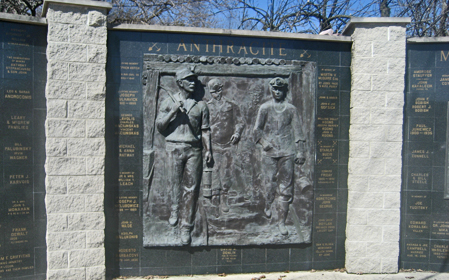
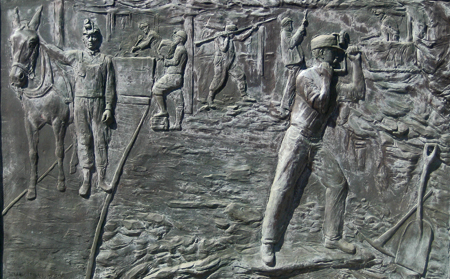
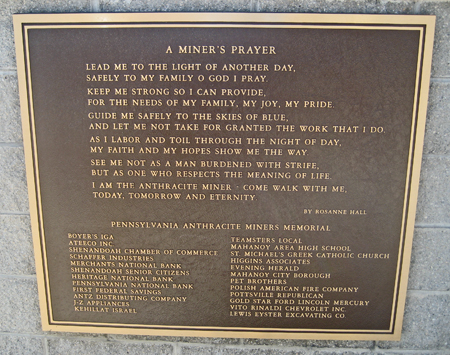
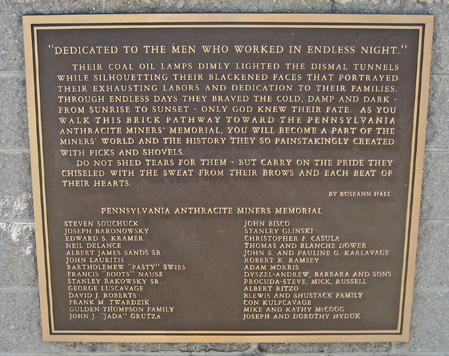
A VISIT TO POTTSVILLE...
HARD COAL - In northeastern Pennsylvania, "Coal" means anthracite, sometimes called "hard coal" because it's almost pure carbon and doesn't break as easily as soft, or bituminous coal. The largest anthracite deposits in the world, by far, are in northeastern Pennsylvania, in two general areas. One is around Pottsville and the other around Scranton and Wilkes-Barre. Anthracite was discovered, legend has it, in the late 1700's by a hunter who woke up amid flames - his campfire had set fire to an outcropping of coal. Because anthracite gives off great heat, "burns clean," and produces relatively little ash, it was long used to heat homes all over the eastern part of the United States, and the "hard coal regions" boomed with activity. Mining the coal, of course, was hard and dirty. And dangerous. The veins of anthracite were located in the folds of the Appalachians, and could only be reached by tunneling underground and blasting the coal loose. Needless to say, few native Americans were interested in the work, and as a result, successive waves of immigrants made their way to the coal regions to mine the anthracite - first the English and the Welsh, then the Irish, then people from Southern and Eastern Europe - Italians, Poles, Lithuanians, Slavs, Ukrainians and Russians. They tended to live among their own kind, often in tiny settlements called "patches," built near the mines where the men worked, in houses owned by the mining companies. They started out young - boys of 10 or 11 began their working lives as "breaker boys," sitting astraddle long conveyors as they picked out the slate from the coal passing underneath them. The companies were not exactly enlightened in their treatment of the miners, and the fight of the miners to unionize and the strongarm tactics of the mining companies resulted in murderous bloodshed in the late 1800s, and the subsequent hanging of three members of the Molly Maguires, a secret Irish union organization. The age of anthracite had petered out by the middle of the 20th century, chiefly because of the introduction of oil for heating homes. There is still a little anthracite being mined, but unfortunately, nothing ever replaced King Coal as a staple of the area's economy, and today, as people left the area in search of work, most towns in the coal regions have fewer than half the number of people they had 100 years ago. Ornate churches still stand in those towns, testimony to an earlier day when they were the centers of the lives of the coal region's ethnically diverse peoples. Large numbers of taverns survive, too, relics of the days when men worked hard and drank hard. And the people themselves - those who have remained behind - reflect in their surnames the varied origins of their ancestors who came here to dig the anthracite out of the ground.
 |
 |
The Anthracite Miners' Memorial stands in the old mining town of Shenandoah ("SHEN-doh") |
Before power tools, men had to drill holes by hand before inserting black powder charges |
 |
 |
The recent deaths in a West Virginia mine show that coal mining will never be as safe as we'd like |
The names on the plaques reflect the varied origins of the people of the Coal Regions |
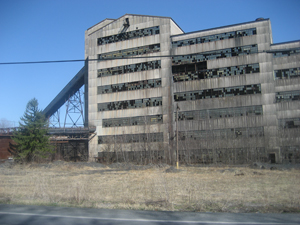 |
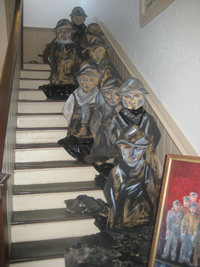 |
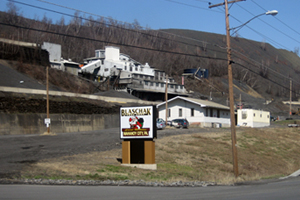 |
| Once called the "Castles of the Coal Region," giant breakers separated coal from slate and broke the coal into the various sizes required by the markets. Now, hulks like this one can still be seen | In the Schuylkill County Historical Society, "Breaker Boys" sit as they might have sat over a converyor, a century or more ago | There's still a little bit of mining going on in the Coal Region. This small mine operation is outside Mahanoy City |
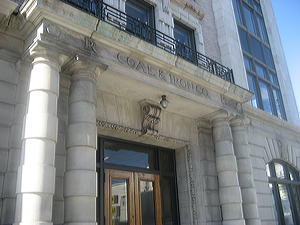 |
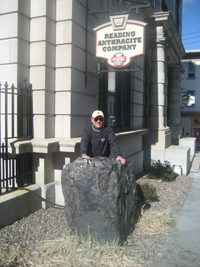 |
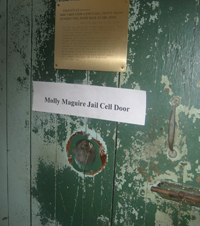 |
| The Pottsville headquarters of the Reading Anthracite Company, descendant of the Philadelphia and Reading Coal and Iron Company, which hired private police to fight striking miners | A chunk of anthracite - a giant "Black Diamond" - stands outside the Reading Anthracite Company headquarters | This jail door stands in the Schuylkill County Historical Society as a reminder of the bloody days of the Molly Maguires |
THE PEOPLE AND THE HISTORY
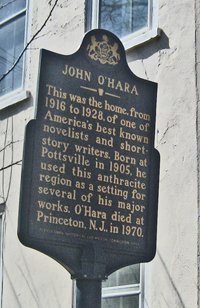 |
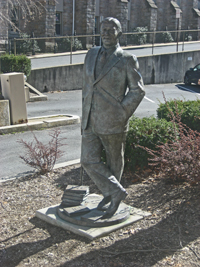 |
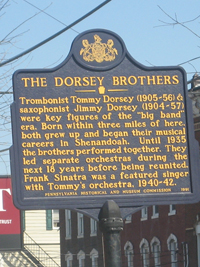 |
||
| Pottsville native John O'Hara remains one of my favorite writers; as a young reporter, he covered the Pottville Maroons (see below) | At the feet of John O'Hara is a stack of books, each representing one of his works | You may not know of the Dorsey Brothers, but they were once as big as it got. Note the last line. |
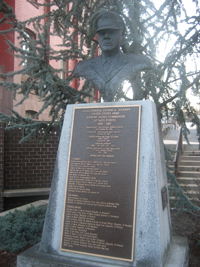 |
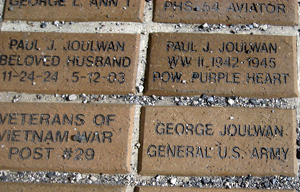 |
| Pottsville boy makes good... George Joulwan went to West Point to play football, and wound up as Supreme Allied Commander in Europe, in charge of NATO | The sidewalk outside the Veterans' Club reveals that patriotism runs in the Joulwan family. Gen Joulwan's cousin, Paul, was a POW in World War II and won a Purple Heart |
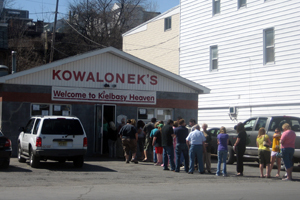 |
| It is a Polish tradition to serve kielbasy at Easter dinner, and as the line indicates, everybody knows that the best place in the area to get kielbasy is Kowalonek's in Shenandoah |
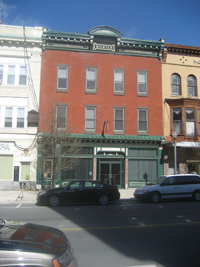 |
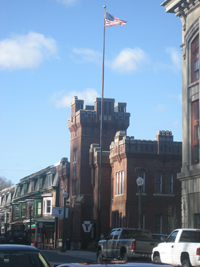 |
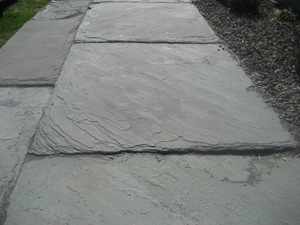 |
| Pottsville has "good bones." A look up at the tops of all the old downtown buildings reveals the ornate cornices of another day | God knows what this old building once housed - I'm guessing a National Guard Armory - but it's now a YWCA | These giant slabs of slate form the sidewalk outside the Reading Anthracite headquarters |
MAROONS - Little Pottsville, which now has fewer than 20,000 people, once had an NFL team called the Pottsville Maroons. Few people are alive to remember them and their story, but a book, "Breaker Boys," tells their story, and ESPN evidently has plans to make it into a movie. (I have long maintained that they have yet to make a good football movie, and I confidently predict that I will still be saying that when ESPN is finished with "Breaker Boys.")
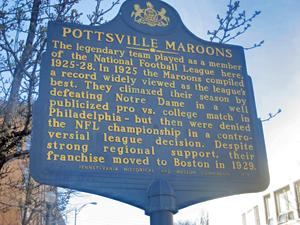 |
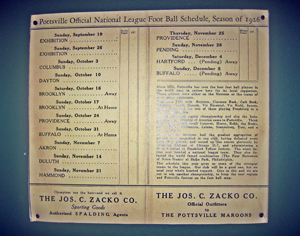 |
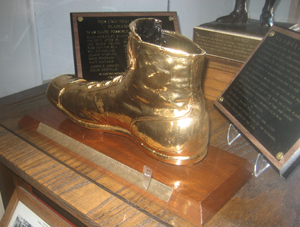 |
| This state historic sign sums up the Maroons' story pretty well | An official Pottsville Maroons' schedule from 1926. Note the name Joseph Zacko, "official outfitter" of the Maroons. Until his death, Mr. Zacko lobbied the NFLfor years to restore the Maroons' 1925 NFL championship, taken from them when they played a post-season exhibition game in Philadelphia, another team's territory |
This is the shoe with which the Maroons' Charlie Berry kicked the winning field goal in the last minute to defeat the Notre Dame All-Stars, 9-7 in the game that would cost them their NFL title. Joe Zacko had it bronzed, and when the Pro Football Hall of Fame asked him for it, he said, "The shoe for our championship." No deal, and there the shoe sits, in the Schuylkill County Historical Society |
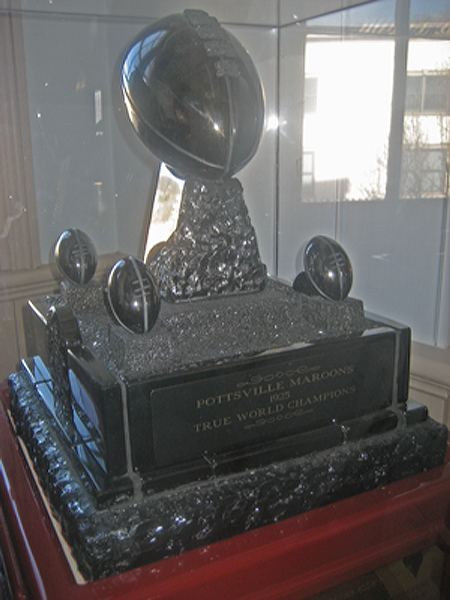 |
| In the absence of a real NFL Championship Trophy, someone had this one made up. Note that it says "TRUE WORLD CHAMPIONS." The trophy is black and shiny, leading me to suspect that it may be made of anthracite coal. My suspicions were confirmed by Pottsville native Gen George Joulwan, who told me, "I helped present it!" |
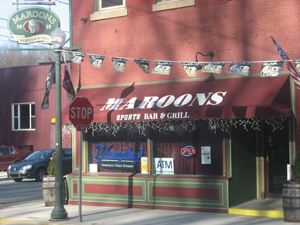 |
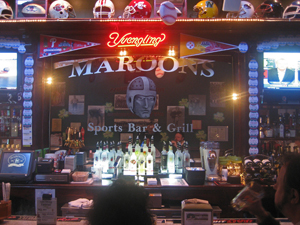 |
| The only tangible evidence that Pottsville was once an NFL town is Maroons, a nice little sports bar. | In addition to the usual pub grub and lots of flavors of Yuengling, the local beer, Maroons has a nice little collection of Pottsville Maroons memorabilia |
YUENGLINGS - the pride and joy of Pottsville is a brewery on a steep hill, just a few blocks from the center of town. There D.G. Yuengling & Son still produces beer, in the same place it has since 1825. It is "America's Oldest Brewery," as Yuengling is proud to tell us in its advertising. Yuengling's, like all smaller brewers, has seen hard times. Unlike the 99 per cent of small brewers who dropped out of the race, though, Yuengling has managed to carve out for itself a prominent place in the New York and Philadelphia markets, to the point where it has had to acquire a brewery in Tampa, and build a new one just outside Pottsville. Just as I once waited for Coors to make it to Washington, I now yearn for the day when I will be able to buy Yuengling - Yuengling Premium, Yuengling Premium Light, Yuengling Lager, Yuengling Lager, Yuengling Porter, Chesterfield Ale and Yuengling Black & Tan - in the Northwest. Good luck.
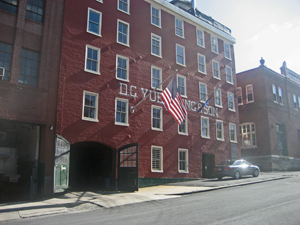 |
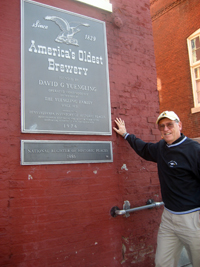 |
| Not only is the Yuengling brewery is located on a steep hill, but much of its original cold storage took place in caves dug into the side of the hill behind this building | Just to prove I've been here... |
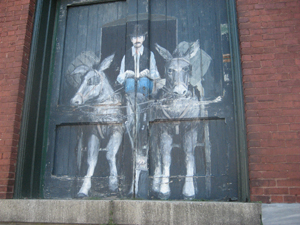 |
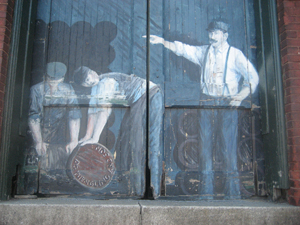 |
| Murals adorn the old brewery doors, hearkening back to the days when deliveries were made by horse- or mule-drawn wagons... | A scene from the days, as the oldtimers would say when I worked in the beer business, of "wooden kegs and iron men." |
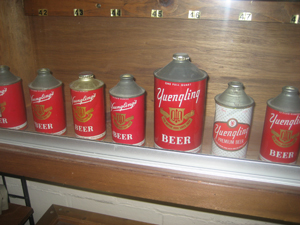 |
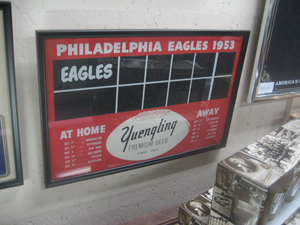 |
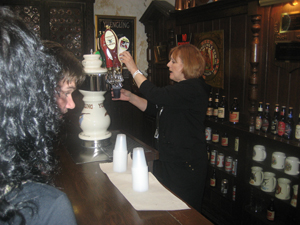 |
| The brewery maintains something of a museum of Yuengling packaging and advertising materials over the years. As a beer can collector myself, I assure you those old cone-tops are valuable! | Hmmm. Any time they want to sell this old 1953 Eagles' schedule, they can give me a call | Every brewery tour ends with a sample or two in the hospitality room - but that's all you get. The last thing any brewer needs is for someone to get sloshed at the brewery |
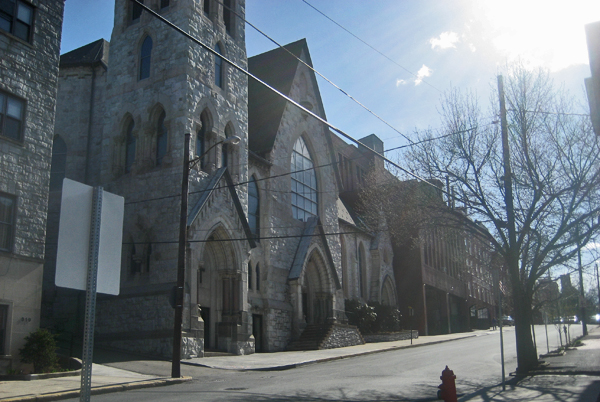 |
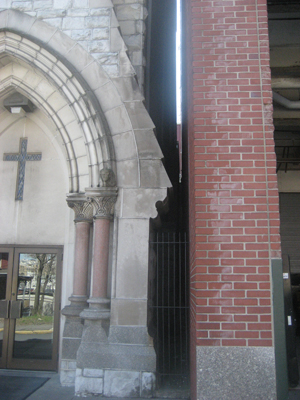 |
|
| THIS is what I call TOLERANCE: Up Mahantongo street from the church is the Yuengling Brewery. Just this side of it - right next to it, in fact - is St. Patrick's Roman Catholic Church | It's a fine line, indeed, between saint and sinner - the brick building on the right is the Yuengling brewery; the stone building on the left is St. Patrick's Church |